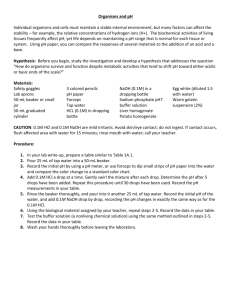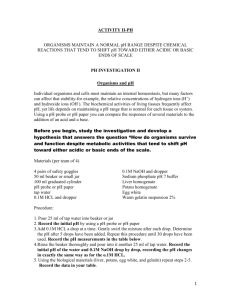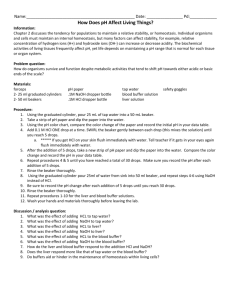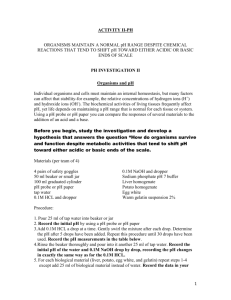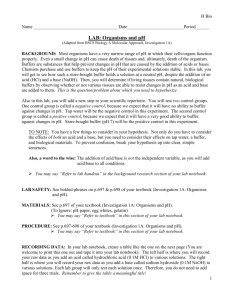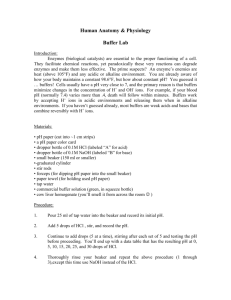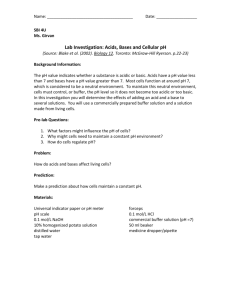biolab3
advertisement
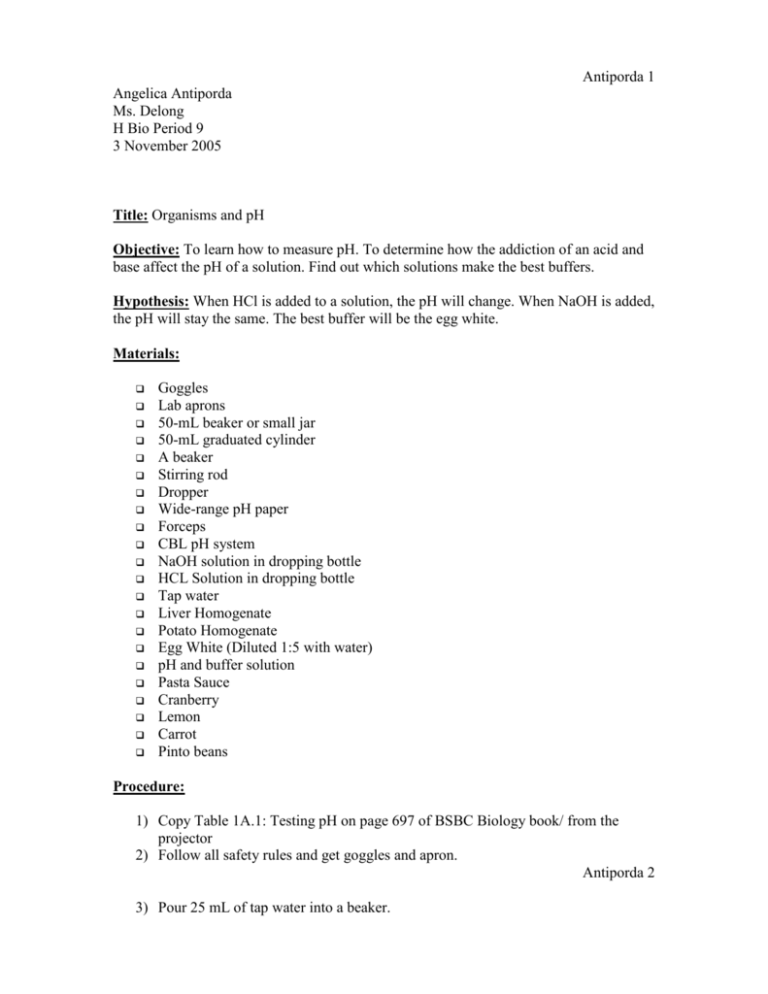
Antiporda 1 Angelica Antiporda Ms. Delong H Bio Period 9 3 November 2005 Title: Organisms and pH Objective: To learn how to measure pH. To determine how the addiction of an acid and base affect the pH of a solution. Find out which solutions make the best buffers. Hypothesis: When HCl is added to a solution, the pH will change. When NaOH is added, the pH will stay the same. The best buffer will be the egg white. Materials: Goggles Lab aprons 50-mL beaker or small jar 50-mL graduated cylinder A beaker Stirring rod Dropper Wide-range pH paper Forceps CBL pH system NaOH solution in dropping bottle HCL Solution in dropping bottle Tap water Liver Homogenate Potato Homogenate Egg White (Diluted 1:5 with water) pH and buffer solution Pasta Sauce Cranberry Lemon Carrot Pinto beans Procedure: 1) Copy Table 1A.1: Testing pH on page 697 of BSBC Biology book/ from the projector 2) Follow all safety rules and get goggles and apron. Antiporda 2 3) Pour 25 mL of tap water into a beaker. 4) Record the initial pH by using a pH meter, or use forceps to dip small strips of pH paper into the water and compare to the color change to a standard color chart. 5) Add 5 drops of HCl to the water and stir with stirring rod. Record the pH on the table. 6) Repeat step 6 until 30 drops have been used. Keep recording the pH measurements in your table 7) Rinse the beaker making sure all traces of past solutions/chemicals etc are gone. 8) Pour 25 mL of tap water and record the initial pH on your table. 9) Add 5 drops of NaOH and record the pH change. Repeat the same process until you have recorded up to 30 drops. 10) Using the materials given by teacher, repeat steps 3-9. Record the data in your table. 11) Clean lab area. 12) Wash hands thoroughly before leaving the laboratory. Data: see attached Analysis: The tap water was affected by the HCl solution. Tap water has a pH of 6 and when 5 drops of the HCl solution was added, the pH decreased to 4. Once another 5 drops was added (making it 10 drops) the pH became 3. Another 5 drops decreased the pH to 2. The following 5 drops and so on it remained the same with the pH of 1. The NaOH solution also affected the tap water. Regular tap water measures at 6 pH and once 5 drops of the NaOH solution was added the pH increased to an 8. The next two five drops of the solution the pH (10 and 15 drops) the pH measured a 9. By the 30th drop the pH had increased to a 12. This proves that the water was greatly affected by both solutions because the measure of the pH either increased or decreased enormously. The total pH change for the 30 drops of HCl added to: Liver: 0.28 (4.25-3.97) Potato: 3.5 (6-2.5) Egg white: 3 (7-4) Gelatin: 1 (3-2) Buffer: 0.6 (8-7.4) Sauce: 0.2 (4.5-4.3) Cranberry: 3 (4-1) Lemon: 0.1 (4.5-4.4) Antiporda 3 Carrot: 4 (6-2) Beans: 3 (6-3) The total pH change for the 30 drops of NaOH added to: Liver: 0.05 (4.3-4.25) Potato: 1.5 (7-6.5) Egg White: 1.93 (9.83-7.9) Gelatin: 1 (3-2) Buffer: 1 (8-7) Sauce: 0 (4.5-4.5) Cranberry: 0 (4-4) Lemon: 0.1 (4.5-4.4) Carrot: 1.2 (7.2-6) Beans: 0.8 (6.8-6) The changes of the measure of pH in the biological materials listed above are much less than the changes in tap water. Tap water decreased by 5 (from 6 to 1) when 30 drops of HCl was added to it. The pH increased by 6 (from 6 to 12) when 30 drops of NaOH was added to it. The majority of the biological materials’ pH changes ranges from 0.8 to 4 while Tap water changed by 5 (when 30 drops of HCl was added) and 6 (when 30 drops of NaOH was added). The biological materials responded to changes in pH much less dramatically than that of tap water. Tap water increased drastically with a pH change of 6 when 30 drops of NaOH was added to it. The biological materials such as such as beans (0.8), lemon (0,1), Sauce (0) and liver (0.05) had less than 1 pH change when 30 drops of NaOH was added. The pH response of the buffer system is my related to that of the Biological materials. The Buffer’s pH changed steadily and slowly like most Biological materials unlike the increased speed of change in tap water. For example the change in buffer when 30 drops of NaOH was added was 1. Biological materials such as Gelatin (1), Carrot (1.2), and Potato (1.5) had either exactly the same amount of change or close to the same amount of change with that of the buffer when NaOH was added. The reaction of the Buffer solution can be served as a model for the response of biological materials to pH changes because of how they react to both HCl and NaOH. Both solutions (HCl and NaOH) had very little effect, for the most part, on the biological materials. The buffer solution reacted the same way to both solutions much like how the biological materials did. Antiporda 4 The buffers would aid the maintenance of a relatively stable environment within a living cell in a changing external environment. The experiment shows that the buffer reacts to both solutions much like the biological materials did. The buffer was able to resist and fight the change according to the measure of its pH. In order for the mechanisms that exist to regulate pH in an organism it must contain a strong buffer. It the buffer is weak to when it comes to resisting change then the mechanisms will not work as effectively as that of a one with a strong stable buffer. After addition of (drops) Tests with 0.1 M HCl After addition of (drops) Tests with 0.1 NaOH Potato Liver 7 6 4.25 6 2 7 5 4.27 4 7.6 3 6 4.5 4.14 3 4.4 7.6 3 5 3.5 4.04 2 15 1 4.4 7.6 3 5 3 4.01 1 20 4.5 1 4.4 7.5 3 4 3 3.97 1 2 4.5 1 4.3 7.4 3 4 2.5 3.97 1 6 6 4.4 4 4.5 7 2 7.9 6 4.25 6 6.5 6.3 4.4 4 4.5 7 2 8.25 6.5 4.28 8 6.5 6.3 4.4 4 4.5 8 2 8.8 6.5 4.22 9 6.6 6.8 4.4 4 4.5 7 2 9.1 6.75 4.27 9 6.7 6.8 4.5 4 4.5 7 2 9.4 7 4.27 10 20 6.7 7 4.5 4 4.5 7 2 9.62 7 4.25 10 25 6.8 7.2 4.5 4 4.5 7 3 9.83 7.5 4.3 12 30 Egg white 2 7.5 4.4 1 4.5 3 3 10 15 Gelatin 8 4.4 1 4.4 3 3 5 Buffer 4.5 1.5 4.4 4 3 0 Pasta Sauce 4 4.4 4 3 25 30 Cranberry 4.4 5 3 10 Lemon 6 4 5 Solution Test 0 drops Carrot 6 Tap water Beans
